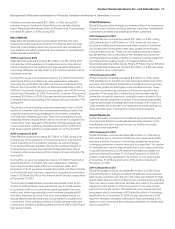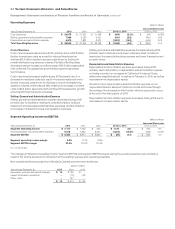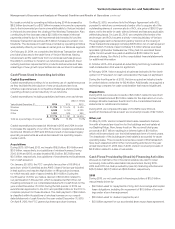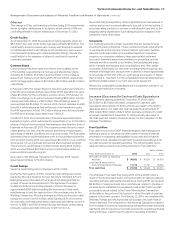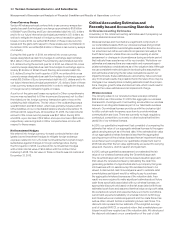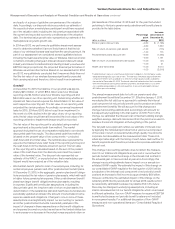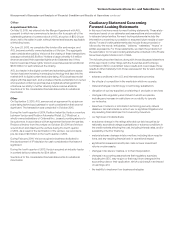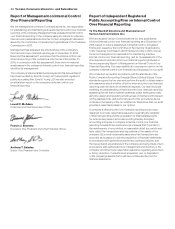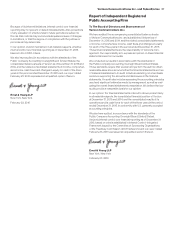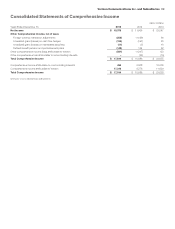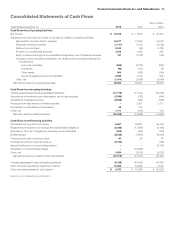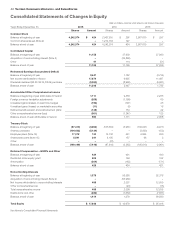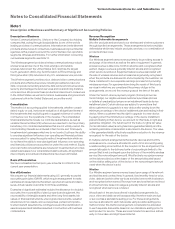America Online 2015 Annual Report Download - page 35
Download and view the complete annual report
Please find page 35 of the 2015 America Online annual report below. You can navigate through the pages in the report by either clicking on the pages listed below, or by using the keyword search tool below to find specific information within the annual report.
and equity of a group of guideline companies as of the valuation
date. Accordingly, our discount rate incorporated our estimate of
the expected return a marketplace participant would have required
as of the valuation date, including the risk premium associated with
the current and expected economic conditions as of the valuation
date. The terminal value growth rate represented our estimate of the
marketplace’s long-term growth rate.
In 2014 and 2013, we performed a qualitative impairment assess-
ment to determine whether it is more likely than not that the fair
value of our wireless licenses was less than the carrying amount. As
part of our assessment we considered several qualitative factors
including the business enterprise value of Wireless, macroeconomic
conditions (including changes in interest rates and discount rates),
industry and market considerations (including industry revenue and
EBITDA margin projections), the projected financial performance of
Wireless, as well as other factors. Based on our assessment in 2014
and 2013, we qualitatively concluded that it was more likely than not
that the fair value of our wireless licenses significantly exceeded
their carrying value and therefore, did not result in an impairment.
Goodwill
At December31, 2015, the balance of our goodwill was approx-
imately $25.3billion, of which $18.4billion was in our Wireless
reporting unit, $4.3billion was in our Wireline reporting unit and
$2.6billion was in our other reporting unit. Determining whether an
impairment has occurred requires the determination of fair value of
each respective reporting unit. The fair value of our reporting units
exceeded the carrying values. Accordingly, our annual impairment
tests for 2015, 2014 and 2013 did not result in an impairment. In
the event of a 10% decline in the fair value of any of our reporting
units, the fair value would have still exceeded the book value of the
reporting unit and no impairment charge would be recorded.
The fair value of the reporting unit is calculated using a market
approach and a discounted cash flow method. The market
approach includes the use of comparative multiples to corroborate
discounted cash flow results. The discounted cash flow method
is based on the present value of two components — projected
cash flows and a terminal value. The terminal value represents the
expected normalized future cash flows of the reporting unit beyond
the cash flows from the discrete projection period. The fair value
of the reporting unit is calculated based on the sum of the present
value of the cash flows from the discrete period and the present
value of the terminal value. The discount rate represented our
estimate of the WACC, or expected return, that a marketplace par-
ticipant would have required as of the valuation date.
• We maintain benefit plans for most of our employees, including, for
certain employees, pension and other postretirement benefit plans.
At December31, 2015, in the aggregate, pension plan benefit obliga-
tions exceeded the fair value of pension plan assets, which will result
in higher future pension plan expense. Other postretirement benefit
plans have larger benefit obligations than plan assets, resulting
in expense. Significant benefit plan assumptions, including the
discount rate used, the long-term rate of return on plan assets, the
determination of the substantive plan and health care trend rates are
periodically updated and impact the amount of benefit plan income,
expense, assets and obligations. Changes to one or more of these
assumptions could significantly impact our accounting for pension
and other postretirement benefits. A sensitivity analysis of the
impact of changes in these assumptions on the benefit obligations
and expense (income) recorded, as well as on the funded status due
to an increase or a decrease in the actual versus expected return on
plan assets as of December31, 2015 and for the year then ended
pertaining to Verizon’s pension and postretirement benefit plans is
provided in the table below.
(dollars in millions)
Percentage
point
change
Increase
(decrease) at
December31,
2015*
Pension plans discount rate +0.50 $ (1,195)
−0.50 1,333
Rate of return on pension plan assets +1.00 (175)
−1.00 175
Postretirement plans discount rate +0.50 (1,565)
−0.50 1,761
Rate of return on postretirement plan assets +1.00 (21)
−1.00 21
Health care trend rates +1.00 3,074
−1.00 (2,516)
* In determining its pension and other postretirement obligation, the Company used a
weighted- average discount rate of 4.6%. The rate was selected to approximate the
composite interest rates available on a selection of high- quality bonds available in
themarket at December31, 2015. The bonds selected had maturities that coincided
with thetime periods during which benefits payments are expected to occur, were
non- callable and available in sufficient quantities to ensure marketability (at least
$0.3billion par outstanding).
The annual measurement date for both our pension and other
postretirement benefits is December 31st. Effective January1, 2016,
we adopted the full yield curve approach to estimate the interest
cost component of net periodic benefit cost for pension and other
postretirement benefits. We will account for this change as a
change in accounting estimate and, accordingly, will account for
it prospectively beginning in the first quarter of 2016. Prior to this
change, we estimated the interest cost component utilizing a single
weighted- average discount rate derived from the yield curve used to
measure the benefit obligation at the beginning of the period.
The full yield curve approach refines our estimate of interest cost
by applying the individual spot rates from a yield curve composed
of the rates of return on several hundred high- quality, fixed income
corporate bonds available at the measurement date. These indi-
vidual spot rates align with the timing of each future cash outflow for
benefit payments and therefore provide a more precise estimate of
interest cost.
This change in accounting estimate does not affect the measure-
ment of our total benefit obligations at year end or our annual net
periodic benefit cost as the change in the interest cost is offset in
the actuarial gain or loss recorded at year end. Accordingly, this
change in accounting estimate has no impact on our annual con-
solidated GAAP results. We estimate the impact of this change on
our consolidated GAAP results for the first quarter of 2016 will be
a reduction of the interest cost component of net periodic benefit
cost and an increase to Net income by approximately $0.1billion.
However, at this time the estimated impact of this change on the
remaining 2016 interim periods and for annual 2016 results cannot
be reasonably estimated because it is possible that in the future
there may be changes to underlying assumptions, including an
interim remeasurement of our benefit obligations, which could result
in different estimates. Our non-GAAP measure for segment EBITDA
is unaffected because net periodic benefit costs are not included
in our segment results. For additional discussion of Non-GAAP
measures and non- operational items see “Consolidated Results of
Operations”.
33Verizon Communications Inc. and Subsidiaries
Management’s Discussion and Analysis ofFinancialCondition and Results of Operations continued


